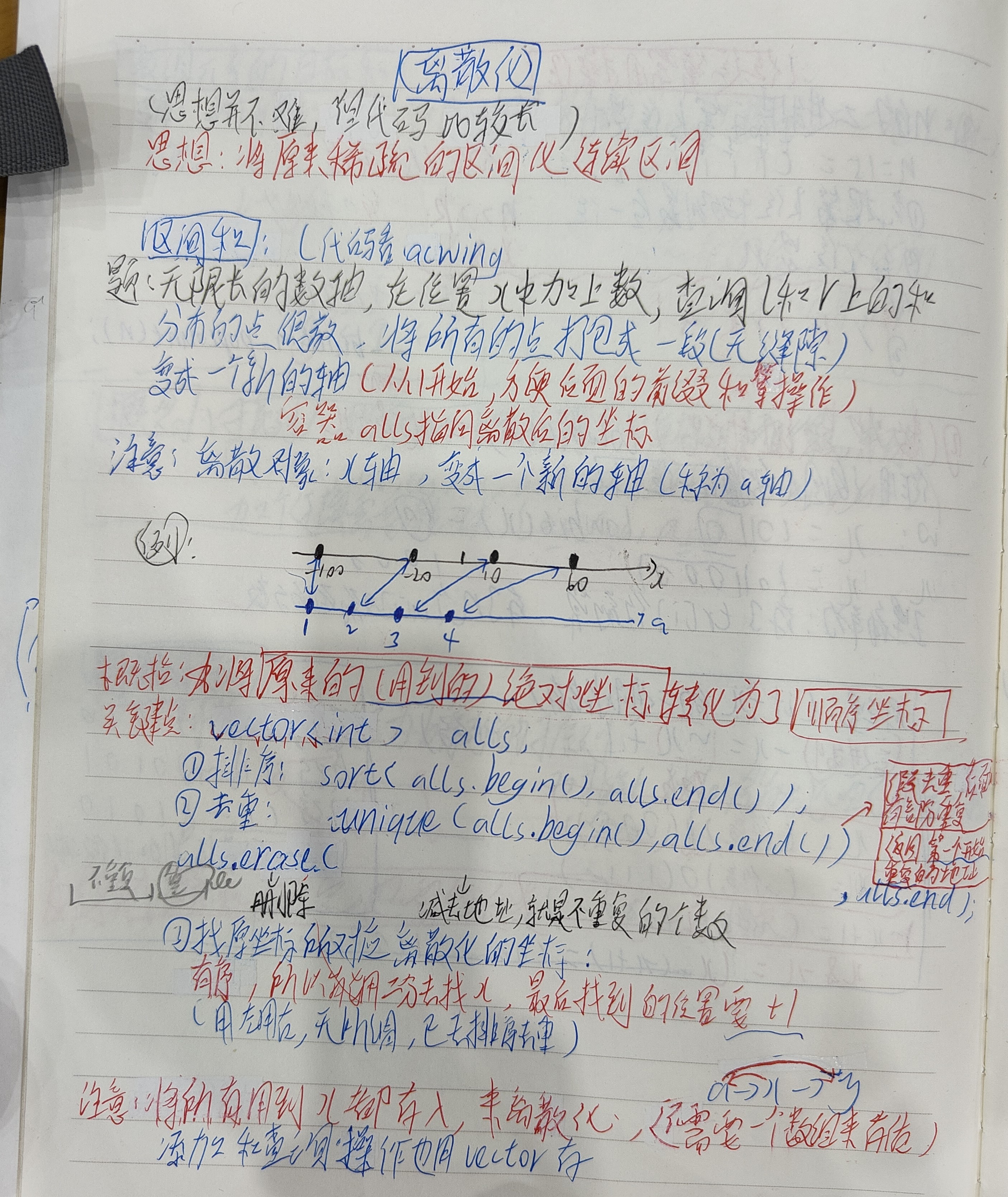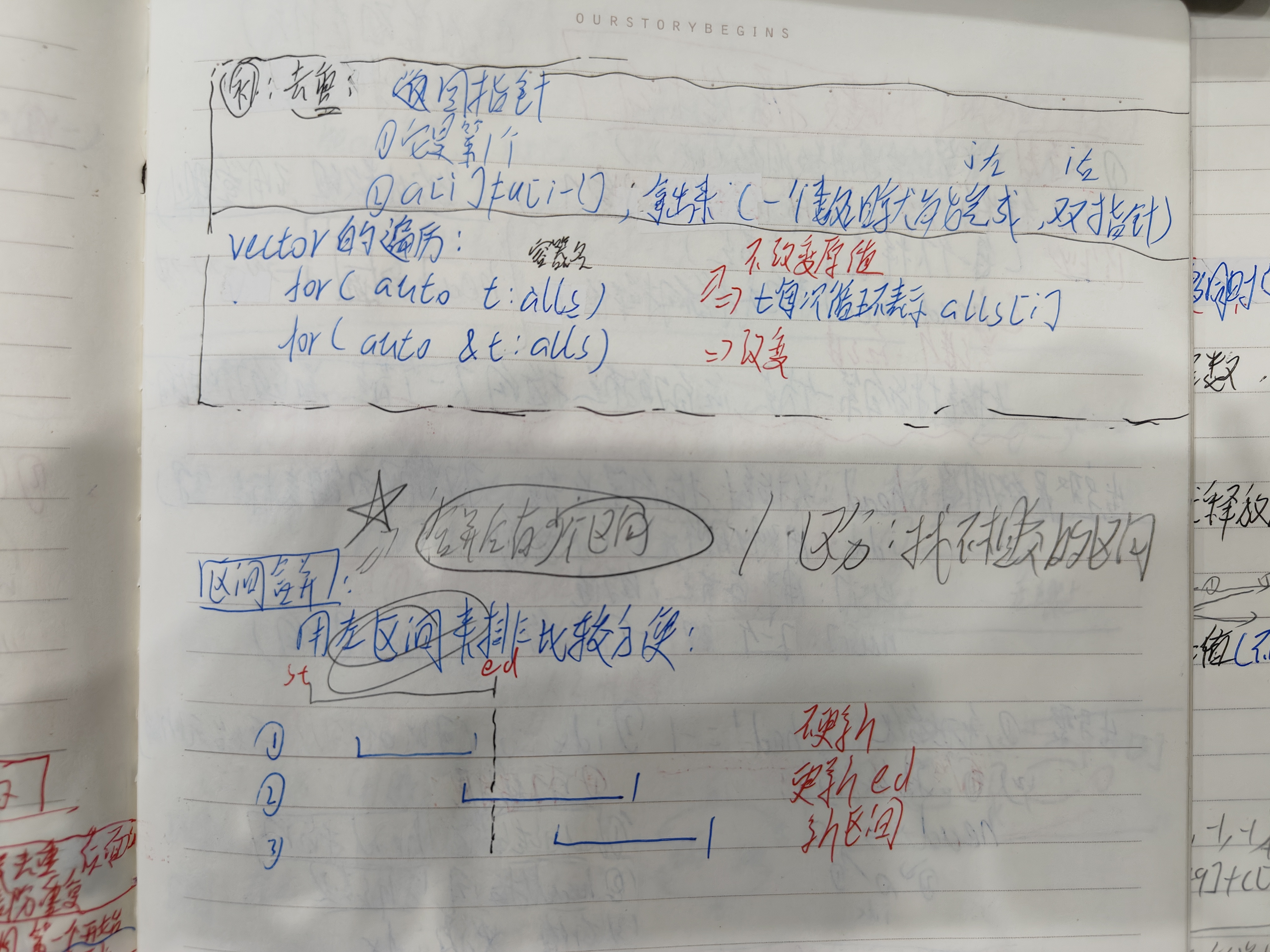离散化
更像集中化
题:
求一个无限长的轴的上,某段区间的和
离散化:把原来第k小的元素映射到下标为k的位置
尽量就是所有出现的点(包括查询),都进行离散化
注意点的总数


c++解法
/*
离散化:(我感觉更像是连续化doge)
将原来稀疏的区间化为连续区间
本题是一段无限长的x轴,其中分布的点很分散,
这时候就可以将所有的点打包成一段区间,并将其中的缝隙去掉,
变成一个新的轴(从1开始,方便便后面的前缀和等操作),点是连续分布的
注意:我们离散的对象是x轴,变成一个新的轴(后面称为a轴了)
例:(将原来的(用到的)绝对坐标转化为了顺序坐标)
点只分布x=-100,x=-20,x=10,x=60
离散后a=1(映射x=-100),a=2(x=-20),a=3(10),a=4(60)
关键点:1.排序2.去重3.找原坐标所对应的离散化的点
*/
#include<bits/stdc++.h>
using namespace std;
const int N=3e5+10;//添加操作和查询操作一共的x坐标数量
int arr[N],sum[N];
typedef pair<int,int> pii;
vector<int> alls;//a轴,离散化后的结果,存的是映射到的x坐标
vector<pii> add,query;//添加操作和询问操作
int find(int x){//找原坐标对应的离散后坐标
//return lower_bound(alls.begin(),alls.end(),x)-alls.begin()+1;//直接用slt
//映射的x坐标是有序的,因此可以用二分
//这里用左用右应该都行
int l=0,r=alls.size()-1;
while(l<r){
int mid=(l+r)>>1;
if(x<=alls[mid]){
r=mid;
}else{
l=mid+1;
}
}
return l+1;
//这里要加1,因为vector默认从0开始存
//加1后是为了方便前缀和的运算
}
int main(){
int n,m;
cin>>n>>m;
for(int i=0;i<n;i++){
int x,c;
cin>>x>>c;
add.push_back({x,c});
alls.push_back(x);
}
for(int i=0;i<m;i++){
int l,r;
cin>>l>>r;
query.push_back({l,r});
alls.push_back(l);
alls.push_back(r);
}
//排序
sort(alls.begin(),alls.end());
//去重
alls.erase( unique(alls.begin(),alls.end()) , alls.end());
//unique返回 第一个开始重复 的地址
//在离散后的坐标中插入值
for(auto t:add){
//t表示遍历add中所有的值,相当于alls[i]
int a=find(t.first);
arr[a]+=t.second;
}
//前缀和
for(int i=1;i<=alls.size();i++){
sum[i]+=sum[i-1]+arr[i];
}
//询问前缀和
for(auto t:query){
int l=find(t.first),r=find(t.second);
cout<<sum[r]-sum[l-1]<<endl;
}
return 0;
}
直接用
pair<int, string> p={1, "world"}就行,其他用得不多pair的初始化:(简单看看就行)
初始化方式 示例代码 特点 直接初始化 pair<int, string> p(1, "hello");简洁,直接构造 列表初始化 pair<int, string> p{1, "world"},p1={1, "world"}支持初始化列表(C++11+) 使用 make_pairauto p = make_pair(2, "C++");类型推导更简便 拷贝/移动初始化 pair<int, string> p2(p1);利用现有对象进行构造 结构绑定(C++17+) auto [k, v] = p;解构绑定元素,代码更清晰 在二分那里使用stl:会比手写要慢
set转vector
//有序集合解法
//这里有边界问题:最后就是连查询操作都要离散化
#include<bits/stdc++.h>
using namespace std;
#define PII pair<int,int>
#define VI vector<int>
#define x first
#define y second
const int N=4e5+10;
int arr[N],sum[N];
set<int> tmp;
vector<int> alls;
vector<PII> query;//查询
vector<PII> add;//操作
int n,m;
int find(int x){
// return distance(alls.begin(),alls.lower_bound(x))+1;
return lower_bound(alls.begin(),alls.end(),x)-alls.begin()+1;
//这里其实用转换为容器的那个更方便,这里主要像用下set
}
int main(){
cin>>n>>m;
for(int i=0;i<n;++i){
int x,c;cin>>x>>c;
tmp.insert(x);
add.push_back({x,c});
}
for(int i=0;i<m;++i){
int l,r;cin>>l>>r;
tmp.insert(l);
tmp.insert(r);
query.push_back({l,r});
}
alls=vector<int>(tmp.begin(),tmp.end());//转换成容器
for(auto& o:add){
int k=find(o.x);
arr[k]+=o.y;
}
for(int i=1;i<=alls.size();++i){
sum[i]=sum[i-1]+arr[i];
}
for(auto& q:query){
int l=find(q.x),r=find(q.y);
cout<<sum[r]-sum[l-1]<<endl;
}
return 0;
}
java版
多看看这个
static Set<Integer> tmp=new TreeSet<>();
static Integer[] alls;
static int find(int x) {
return Arrays.binarySearch(alls, x)+1;//这里已经避免了边界问题了
}
//自动排序并去重
//变成数组
alls=tmp.toArray(new Integer[0]);//转换成Integer[]
完整代码:
// package 基础算法;
import java.io.*;
import java.util.*;
public class Main{
static final int N=(int)3.5e5+10;
static int n,m;
static Set<Integer> tmp=new TreeSet<>();
static List<Map.Entry<Integer,Integer>> add=new ArrayList<Map.Entry<Integer,Integer>>(),query=new ArrayList<Map.Entry<Integer,Integer>>();
//这里其实是Pair,不想定义一个新的类了
static Integer[] alls;
static int[] arr=new int[N],sum=new int[N];
static int find(int x) {
return Arrays.binarySearch(alls, x)+1;//这里已经避免了边界问题了
}
public static void main(String[] args) throws Exception {
BufferedReader br=new BufferedReader(new InputStreamReader(System.in));
BufferedWriter bw=new BufferedWriter(new OutputStreamWriter(System.out));
String[] ss;
ss=br.readLine().split(" ");
n=Integer.parseInt(ss[0]);m=Integer.parseInt(ss[1]);
for(int i=0;i<n;++i) {
ss=br.readLine().split(" ");
int x=Integer.parseInt(ss[0]),c=Integer.parseInt(ss[1]);
add.add(Map.entry(x,c));
tmp.add(x);
}
for(int i=0;i<m;++i) {
ss=br.readLine().split(" ");
int l=Integer.parseInt(ss[0]),r=Integer.parseInt(ss[1]);
query.add(Map.entry(l,r));
tmp.add(l);
tmp.add(r);
}
//自动排序并去重
//变成数组
alls=tmp.toArray(new Integer[0]);//转换成Integer[]
for(Map.Entry<Integer, Integer> a:add) {
int k=find(a.getKey()),c=a.getValue();
arr[k]+=c;
}
//求前缀和
for(int i=1;i<=alls.length;++i) {
sum[i]=sum[i-1]+arr[i];
}
//查询
for(Map.Entry<Integer, Integer> q:query) {
int l=find(q.getKey()),r=find(q.getValue());
System.out.println(sum[r]-sum[l-1]);
}
bw.flush();
}
}
需要注意的是,为了避免返回
Object类型的数组,可以传递一个指定类型的数组作为参数,如果数组大小不够,则会创建一个新数组。==最后变为数组时
new Integer[0],万千别忘了==
Set<Integer> tmp=new TreeSet<>();
tmp.add(2);
tmp.add(2);
tmp.add(2);
tmp.add(1);
tmp.add(3);
Integer[] alls=new ArrayList<Integer>(tmp).toArray(new Integer[0]);
System.out.println(Arrays.toString(alls));

